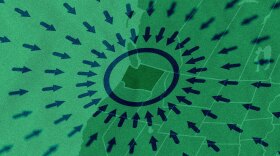How many ways do you know to save someone who's dying?
A good first step is to call 911. If the person's heart has stopped, then it's time for CPR. And, third on your list might be the AED, or automatic external defibrillator.
Emergency responders are hoping this electronic heart-shocking device will become a standard part of the workplace.
"It tells you step-by-step exactly what to do. All you need to do is be able to listen to the directions. So anybody can use this," says Megan Bloomingdale, an emergency medical technician and trainer for King County.
Typically, you’ll find an AED mounted in a small box on a wall in public places, like a fire extinguisher. It’s in a carrying case the size of a toaster. The details vary slightly depending on the brand, but, typically, when you open it up, the instructions are pretty simple.
Once it's on, it's like listening to a GPS in your car. A voice says things like:
"Analyzing heart rhythm."
"Deliver shock now. Press the orange button now."
'"Shock delivered. Pause."
The modern AED evolved in the 1990's, after efforts to make it basically fool-proof. Then, regulations and laws had to catch up, so people wouldn't worry about being held liable if the device failed. Shocking someone whose heart has stopped can boost the chances of survival dramatically.
"It will not shock unless that body needs it. So, you can't hurt somebody with it," says Bloomingdale.
They’ve been in arenas and shopping malls for several years. Now, the push is on, at least in King County, to get them into all kinds of public places.
What would really help is if every business would register their defibrillator with the emergency system, says King County Emergency Services medical director Mickey Eisenberg. That way, a 911 operator can tell anyone on the phone where the nearest device is.
If your business or office is more than four minutes away from a fire station, you might consider adding one, says Eisenberg. They cost around $1,500.







